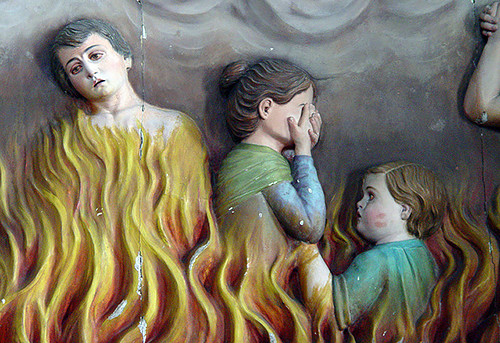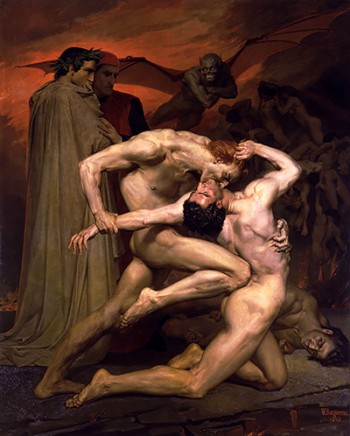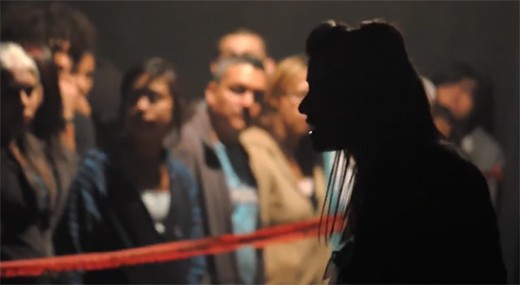
Kelly J. Baker
“We provide the stage but the one on trial is you.”–Trinity Church’s Hell House 25
I want to go to a Hell House, the evangelical Christian alternative to the ubiquitous haunted houses that pop up every October. I say this almost every year, but I’ve yet to attend one. I’ve only had near misses. When I was in high school in the 1990s, local churches took their youth groups to a Judgement House, the kissing cousin of the Hell House, in Dothan, Alabama. The ride was about 90 minutes round trip, but Judgement House’s message about dangers of the modern world were apparently worth cramming boisterous teens into buses and church vans. Instead of ghosts, zombies, vampires, or ax-wielding murderers, this haunted house pursued an otherworldly goal: your salvation. Youth ministers seemed convinced that teens needed to see the consequences of sin and the tortures of hell. Hell Houses and Judgement Houses provided the material evidence of what happened to those who strayed from the righteous path. They are cautionary tales, filled with violence and gore, to scare the hell out of you. I had friends from various youth groups invite me to go, but I dodged their invitations. Chris, a friend (and now husband), attended a Judgement House with the Presbyterian youth group. When I asked him about the experience recently, he remembered the altar call most vividly. The exhaustion of entering the final room after being hustled from one scene of sin to another. The command to close your eyes and raise your hand if you want to be saved. The uncomfortable silence while waiting for the organizers to dismiss your group. When he opened his eyes, one of his friends was gone. She had raised her hand, and the members of the ministry team took her to another room to pray. “They took her,” he tells me. His anger and frustration with her absence blunted by time and his sense of humor. But, he could not recall the actual scenes (“Drunk driving, maybe?). Vague impressions were all that remained. His lack of memory would be disappointing to the churches that run Christian haunted houses. They seek to make fearful impressions to save your soul; they do not want to be so easily forgotten. When I was teaching in Tennessee, I attempted to attend a Judgement House at a Baptist church in Sevierville. The roads were dark and winding, so I missed my turn and ended up in the touristy Gatlinburg instead. As I tried to navigate my way to the church, my cell phone rang. “Hello,” I muttered grumpily while attempting to keep my focus on the road. “Hello, is this Dr. Baker?” asked the cheerful Judgement House coordinator. She had called to find out why I missed my reservation and to reschedule me for another time slot that night. When I asked about her apparent eagerness to have a religious studies PhD attend, she explained, “We want you to experience the Judgement House to show you what salvation offers.” I thought they were explicitly using horror to frighten attendees into a belief in Jesus. It occurs to me now that maybe my perception was not actually that distant from what she said to me on the phone. Unfortunately, I couldn’t make it to the other available times. I missed out on both the horrors of sin and the promise of salvation. I’ve had to make do with George Ratliff’s 2001 documentary, Hell House, which I’ve screened for years in my courses on religion and gender, apocalypticism, and horror. The film follows the youth ministry of Trinity Church, located in Cedar Hill, Texas, as they plan, write, audition, build, rehearse, and perform their Hell House. It is a months-long ordeal to create and materialize the wages of sin. I’m left with the lingering impression that it takes a lot of time and effort to scare the hell out of you.
“I wish you didn’t have to see what you’re gonna see,” Trinity’s youth pastor, Tim Ferguson, explains to the camera. He warns us about the dangers of our secular culture. Hell House is his church’s attempt to save us from the perils. If he doesn’t try, there will be blood not only on our hands, but on his too. In a meeting with the leaders of Hell House, Ferguson reminds them, “We do this for a purpose: to reach the lost.” Their explicit goal is to convert attendees. Hell House X’s theme was “Walking Dead”: without the saving power of Jesus, that’s all we are. (It is disconcerting to encounter their theme in 2015 when the phrase is inseparable from zombies I study). Part of salvation, at least for the Hell House organizers, is the fear of going to hell. Enacting sin and damnation for audiences is a recognition of horror’s power to push the lost (the unsaved) toward salvation. They claim conversions and re-dedications for 1 in 5 attendees. Fear appears mildly effective. The scenes remain consistent: abortion, AIDS, drug deals, drunk driving, family violence, the occult, and raves. Each year brings new takes on the same content. Infamously, Trinity featured a Columbine scene only months after the school shooting occurred. Despite the controversy surrounding Hell House, members of the church, young and old, are eager to audition for specific scenes. The organizers rely not only on acting abilities, but also “faithfulness” and commitment to the church to decide who gets each part. There’s the suicide girl, the AIDs patient, the abortion girl, the drunk driver, the drug dealer, the adulterous wife, the school shooter, and many more smaller roles that populate the scenes. Death monitors, a rendering of demons, antagonize the sinful and eventually cart them off to hell. One young man complains about being typecast into one particular scene each year. “I’m praying the spirit will lead you away from the drug deal scene,” he pleads with the organizers. The competition is serious for the female leads, particularly the suicide and abortion girls. Teen girls cry, scream, shudder, yell, convulse, and cry more as they attempt to land their preferred roles.

Hell House requires not drama, but melodrama. One of the leaders of the Hell House explains that she used to play the suicide girl as a teenager. The role never really worked for her because it connected to an incest scene. One night while she waited for the scene to begin, she panned the crowd and saw the guy who raped her two years earlier. As the death monitor taunted and shamed her about being raped, she realized that she should forgive her rapist. This is one of the most haunting moments in the documentary. Her story deflates my lungs. I struggle to breathe as I hear her embrace forgiveness for the man who assaulted her. I worry about the messages that Hell House provides audiences about violence and victimhood. Why are women’s bodies the particular media for Hell House’s message? Why must their female characters be broken and damned? In The Religion of Fear: The Politics of Horror in Conservative Evangelicalism, Jason Bivins writes, “the body is the locus of the politics of Hell House.”[1] The scenes, particularly AIDS and abortion, suggest a conservative political ideology, in which characters are punished for supposedly choosing sin. Young female characters are damned for any encounter with sexuality. Bivins argues that these Christian haunted houses are antifeminist. I want to push his analysis further. This particular version of the religion of fear is not only antifeminist, but misogynist. Hell Houses are built upon the fictional destruction of women’s bodies.

Hell House tortures women’s bodies to send messages about morality, chastity, and the peril of sexuality. The bodies of the lost are feminine in shape. A girl, who is date-raped at a rave, later commits suicide while being slut-shamed by a death monitor. An abortion gone wrong kills another young woman, but not before we hear her ear-splitting screams and see her anguish, physical pain, and so much blood. A husband chokes to death his adulterous wife. A drunk driving boyfriend crashes his car killing both him and his girlfriend. A disastrous drug deal begins with one dealer’s girlfriend being shot to death in front of him. Before these female characters die, men insult, threaten, choke, slap, push, and rape them. These young women die by their own hands or the hands of another, death monitors drag them to hell. An angel spares the abortion girl, who cries out to God to be saved. She finds salvation, but loses her life. Women’s bodies appear broken and wounded. They are clearly victims. Yet, the victims are the ones punished for eternity while their victimizers suffer no such fate. Hell House normalizes male violence while vilifying and damning female victims. Trinity’s teens role play at sin, but the effects of sin appear starker for young women than young men. Who wants to play as a rapist or domestic abuser? Unless they both walk away from consequences in everyday life and the afterlife. Salvation and damnation are gendered. Hell House makes that clear. After rewatching Hell House, I was sort of relieved that I couldn’t find a Hell House or Judgement House near me. I was also surprised about their lack of presence. Perhaps their popularity has started to wane. I’ll miss my chance to go again this year. Possibly, I’ll never attend. To be honest, I’m glad for the near miss. I’m uncertain that I could make it all the way through the tour without losing my temper. I’m not sure I want to be close enough to touch the suicide or abortion girls. I don’t want my entrance fee to support their vision of the world, and I definitely wouldn’t stay for the altar call. Instead, I’ll take my kids trick-or-treating. My oldest wants to be a black cat or a bunny, and my youngest a pirate. We’ll celebrate Halloween with candy, jack-o-lanterns, and traipsing through the neighbor together.
Kelly J. Baker is a freelance writer with a Religious Studies PhD who covers higher education, gender, labor, motherhood, American religions, and popular culture. She is the author of Gospel According to the Klan: The KKK’s Appeal to Protestant America (2011) and The Zombies are Coming! (2013). She can be followed @kelly_j_baker. [1] Jason Bivins, The Religion of Fear: The Politics of Horror in Conservative Evangelicalism, (Oxford, 2008), 164.
